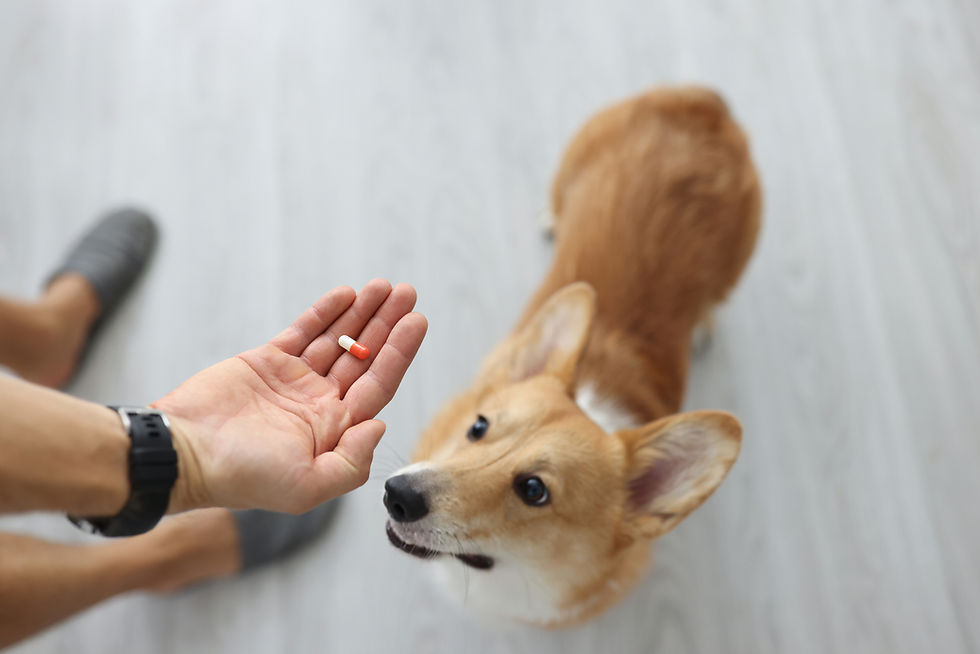Does Your Dog Really Have Hip Dysplasia—Or Could It Be Something Else?
- Dr. Angelique Barbara

- Aug 20
- 4 min read

Many dogs with hind-end stiffness or “bunny-hopping” get labeled with hip dysplasia (HD), but those same signs can come from several different problems. Getting the right diagnosis matters—because the best plan for comfort, mobility, and longevity depends on what’s actually wrong.
Below you’ll find a clear guide to what hip dysplasia is, what commonly mimics it, and practical, gentle bodywork strategies you can use (with your veterinarian’s OK) to help your dog move and feel better—whatever the underlying cause.
Important: This article is educational and not a substitute for veterinary care. If you suspect HD or your dog has new or worsening lameness, see your vet. Radiographs (X-rays) are the gold standard for diagnosing hip dysplasia and osteoarthritis.
What Hip Dysplasia Is (in plain English)
Hip dysplasia is a mismatch between the ball (femoral head) and socket (acetabulum) of the hip joint—too shallow, too loose, or both. Over time that laxity leads to secondary osteoarthritis (OA). Common signs include:
Bunny-hopping at a trot, reluctance to jump or use stairs
Stiffness after rest, trouble rising, hind-end swaying
Shortened stride behind, muscle loss over the thighs
Discomfort when the hips are extended or rotated
Conditions That Can Mimic Hip Dysplasia
If your dog’s X-rays are normal—or the symptoms don’t quite fit—consider these look-alikes:
Iliopsoas (psoas) strain/tendinopathy – groin pain, worse with quick turns or jumping.
Cranial cruciate ligament (CCL) injury – stifle (knee) pain causing hind-end lameness and thigh muscle loss.
Patellar luxation – kneecap slips; skipping steps, intermittent lameness.
Lumbosacral (cauda equina) pain – back/nerve pain, reluctance to sit, possible neurologic signs.
Sacroiliac (SI) dysfunction – pelvic asymmetry, shortened stride, sensitivity over the croup.
Hock or stifle arthritis – joint pain lower down can look like hip trouble.
Neurologic disease – e.g., degenerative myelopathy; weakness more than pain.
Foot/nail/pad pain – long nails, cracked pads, or toe arthritis alter gait.
Tick-borne disease – shifting lameness, malaise (depends on region).
A thorough exam helps sort these out; sometimes you’ll need imaging (X-ray/ultrasound), orthopedic tests, or neuro evaluation.
Bodywork Principles That Help Most Hind-End Issues
Whether it’s HD or a mimic, these foundations improve comfort and movement:
Go gentle, go proximal: Start with light work to the back, glutes, and thighs before moving closer to the painful joint.
Short sessions, often: 10–20 minutes, 3–5 days/week beats one long session.
Work both sides: Treat compensations, not just the obviously sore limb.
Watch for releases: Softer eyes, sighs, weight shift, deeper breathing = good signs.
Stop if pain increases: No grimacing, flinching, or guarding.
A Hip-Friendly 15-Minute Home Routine
Warm-up (2 min): Gentle stroking (effleurage) over the low back, glutes, and thighs.
Melting holds (3–4 min): Light sustained holds along the TFL, gluteals, and hamstrings; think 3–5/10 pressure.
Myofascial glide (3–4 min): Slow palm or forearm glides along the thigh toward the hip; avoid deep pressure on hot, inflamed areas.
Craniosacral/ANMR-style inputs (2–3 min): Tiny pelvic balancing holds and lumbar decompression; less is more.
Pain-free ROM (2–3 min): Bicycle the hip in a tiny, comfortable arc; stop before resistance.
Cool-down (1–2 min): Long, calming strokes; then a brief leash walk on non-slip footing.
Tip: For acute “hot” flares, skip deeper work. Think lymphatic-light touch and rest; add modalities like cold laser only with your vet’s guidance.
Want to learn more about home exercies? Check out our online course: HOME TREATMENT FOR ARTHRITIC DOGS
View our other courses for dog owners BY CLICKING HERE.
Targeted Approaches by Condition
Confirmed Hip Dysplasia / Hip OA
Massage & myofascial release to TFL, gluteals, piriformis, hamstrings, and lumbar paraspinals.
Kinesiology taping for hind-end awareness/support (Y-strip gluteal facilitation; light “space-correction” over tender points).
Laser acupuncture / cold laser for pain modulation and tissue health.
Strength & stability: weight-shifts, slow figure-8s on good footing, low cavaletti, underwater treadmill if available.
Environment: non-slip rugs, ramps, raised food/water, supportive bed.
Iliopsoas Strain
Relative rest (no fetch/jumps).
Gentle heat later-stage; psoas-safe release (indirect, never pokey).
Progress to controlled strengthening (sit-to-stand, backing up, hill walking).
Taping to unload hip flexors and support the lumbar area.
CCL Injury (non-surgical or post-op)
Straight-line leash walks, gradual time increases.
Quad/glute activation, controlled sit-to-stand.
Stifle-support taping; address back/hip compensations.
SI/Lumbosacral Discomfort
Pelvic balancing holds, lumbar decompression, gentle core work.
Avoid extreme hip extension; focus on posture and even weight-bearing.
Weight, Nails, and Traction: The Big Three
Lean body condition dramatically reduces joint load—ask your vet for a target weight.
Regular nail trims improve hind-end mechanics and reduce slipping.
Traction (rugs, socks with grips) prevents micro-injuries and boosts confidence.
Smart Supplement Support
Combine bodywork with a high-quality joint supplement. We recommend Holistic Bite’s Hip & Joint (developed and recommended by Dr. Angel) to support cartilage, comfort, and mobility.👉 https://www.holisticanimalstudies.net/product-page/canine-hip-and-joint-soft-chews

Always discuss supplements with your veterinarian—especially if your dog is on other medications or has liver/kidney concerns.
When to See the Vet (or Re-check)
Sudden non-weight-bearing lameness
Rapid swelling, heat, or fever
Neurologic signs (knuckling, crossing limbs, incontinence)
Pain that worsens despite rest and gentle care
A Simple Weekly Plan (Example)
Mon/Wed/Fri: 15-minute bodywork routine + 10–20 min controlled walk
Tue/Sat: Foundational exercises (sit-to-stand, weight-shifts, backing up)
Thu: Rest or light leash stroll only
Daily: Nail check/traction, brief posture tune-ups, joint supplement, log a 15-second walk/trot video for progress
Bottom Line
Hip dysplasia is common—but it’s not the only cause of hind-end trouble. A precise diagnosis plus calm, consistent bodywork, smart environmental tweaks, and a science-backed joint supplement can transform your dog’s comfort and confidence.



Comments